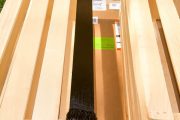(BPT) – If you’re a homeowner, you learn that when something goes wrong involving water, it’s going to cost you. Water damage, mold or mildew — and wasted water — means more expenses, especially the longer it continues. Sometimes you need a plumber to help address the issue, but there are repairs you can take care of yourself.
Here are common household repairs you can handle, with the right supplies and a little know-how.
1. Redo bathtub caulk
If that black stuff on the caulk around the tub just won’t come off, there’s just too much mold or mildew. Not only is this unsightly, but it will keep spreading, and may indicate water is seeping beneath the caulk. Your best bet is to recaulk the entire tub.
Remove old caulk using a putty knife and/or chemical caulk remover. A plastic putty knife can help reduce the risk of damage to the tub. After peeling the caulk away, make sure to remove all the old caulk. Use mineral spirits or rubbing alcohol on a rag to remove residue and clean thoroughly. Let dry before caulking.
Painter’s tape helps keep caulk off the rest of the tub or tiles. Follow the instructions on the caulking gun to apply caulk, using your finger to smooth into the seam. Remove painter’s tape before the caulk dries, and don’t shower for several hours after caulking, following your product’s instructions.
2. Swap out your showerhead
If your showerhead malfunctions or you want an upgrade, this is a simple fix. One necessary product for this task — or to fix a leaky faucet — is thread sealant. This will help ensure you won’t have future leaks. Thread sealant tape like Hercules Megatape is easy to use and comes in several colors, widths, thicknesses and densities. Using gray color tape will match the finish of the fixture so it looks better.
Wrap thread sealant tape clockwise several revolutions around to fully cover the threads. Clockwise is the same direction you’ll be screwing on the showerhead, so applying the tape in the same direction prevents the new showerhead from catching the end of tape and unraveling it. Watch this short video showing the process.
3. Replace a faucet aerator
If your sink faucet squirts oddly or the water runs unevenly, the aerator may need replacing. The aerator screws on the end of the faucet to introduce air into the water stream. Unscrew the aerator counterclockwise. If the screen is clogged, tap or rinse to clear debris, and replace. If there’s nothing clogging the screen, simply purchase a new faucet aerator at any hardware or home improvement store. It’s easy to screw a new one on the end of your faucet, clockwise.
4. Stop a running toilet
If your toilet keeps running, you’ll be paying for excess water on your next utility bill. Most often the flapper at the bottom of the toilet tank is old and worn, or your tank ball (float valve) is broken. Purchase a new float valve assembly at your local hardware or home improvement store. To replace, turn off water to the toilet and flush to remove water from the tank. Unhook the chain at the tank lever arm and remove the old flapper. Clean the area under the flapper with a sponge before installing the new one.
Install the new assembly following the instructions on your product. Turn the water back on to fill the tank, ensuring the flapper seals well and doesn’t let water leak into the bowl. Adjust the chain or strap if needed: If it’s too tight, the flapper won’t seal properly, causing water to leak. Too loose, it will cause the flapper to drop too soon, not allowing the bowl to flush correctly. Flush a few times after the tank has filled to make sure it’s working correctly.
5. Repair a broken toilet flange
If you notice your toilet rocking or shifting (the whole toilet, not the seat), spot leaking near the toilet base, water on the floor, and/or unpleasant smells, you could have a damaged toilet flange. You may even see water damage on the ceiling of the room below. The toilet flange is the part that helps secure your toilet to the floor, and it can easily be repaired with an Oatey Fix-it Repair Ring. This makes it possible to repair broken, cracked or worn-out toilet mounting flanges without having to replace the entire flange. It’s compatible with all flange and toilet installations as well as flooring types (including concrete), and has 10 mounting holes and 4 slotted mounting tabs for a range of installation options. Learn how to install a Fix-It Repair Ring by watching this short video.
A plumbing problem, while bothersome, doesn’t have to mean even more expenses like costly repair bills. Visit Oatey.com for these and other DIY repair products.

